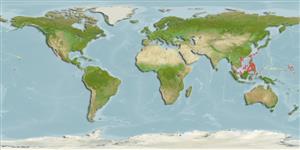Teleostei (teleosts) >
Kurtiformes (Nurseryfishes, cardinalfishes.) >
Apogonidae (Cardinalfishes) > Pseudamiinae
Etymology: Gymnapogon: Greek, gymnos = naked + Greek, pogon = beard (Ref. 45335).
More on author: Herre.
Environment: milieu / climate zone / depth range / distribution range
Ecology
Marine; reef-associated; depth range 0 - 9 m (Ref. 57178). Tropical; 30°N - 1°N
Pacific Ocean: Philippines, Taiwan, Ryukyu Islands, Kapingamarangi and Marshall Islands (Ref. 275) south to Australia (Ref. 75174). Recently reported from the Chesterfield Islands (Ref. 11897) and Tonga (Ref. 53797).
Size / Weight / Age
Maturity: Lm ? range ? - ? cm
Max length : 5.0 cm SL male/unsexed; (Ref. 48635)
Sometimes occurs in schools of Rhabdamia gracilis (Ref. 1602). Rarely noticed because of small size (Ref. 48635). Occasionally collected with ichthyocides (Ref 90102).
Life cycle and mating behavior
Maturity | Reproduction | Spawning | Eggs | Fecundity | Larvae
Distinct pairing during courtship and spawning (Ref. 205).
Myers, R.F., 1991. Micronesian reef fishes. Second Ed. Coral Graphics, Barrigada, Guam. 298 p. (Ref. 1602)
IUCN Red List Status (Ref. 130435: Version 2024-1)
Threat to humans
Harmless
Human uses
Tools
Special reports
Download XML
Internet sources
Estimates based on models
Preferred temperature (Ref.
123201): 25.4 - 29.1, mean 28.7 °C (based on 636 cells).
Phylogenetic diversity index (Ref.
82804): PD
50 = 0.5039 [Uniqueness, from 0.5 = low to 2.0 = high].
Bayesian length-weight: a=0.00389 (0.00180 - 0.00842), b=3.12 (2.94 - 3.30), in cm total length, based on all LWR estimates for this body shape (Ref.
93245).
Trophic level (Ref.
69278): 4.0 ±0.50 se; based on food items.
Resilience (Ref.
120179): High, minimum population doubling time less than 15 months (Preliminary K or Fecundity.).
Fishing Vulnerability (Ref.
59153): Low vulnerability (10 of 100).
